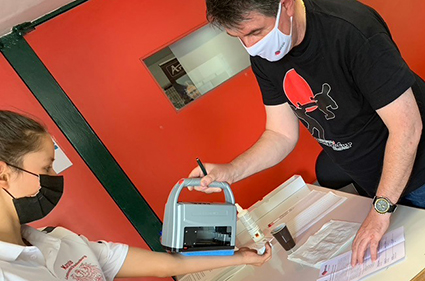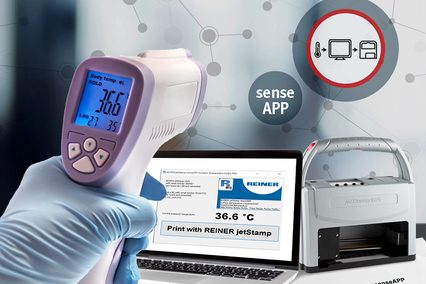You are here:
Print graphic
Mobile Printing of manufacturer Symbols, Marks, Logos, Test Marks or Seals on the Product and Packaging
Print graphic
REINER® marking devices perform perfect graphic printing right onto many materials
Many small producers and craftspeople do not merely sell a product. They offer their customers a share in their pride and self-definition in the form of their honey jars, wooden chairs or roasted coffee.
As a logical consequence, they want to mark their products with their logos permanently and in high quality. A lot of legally mandatory and voluntary information is to be added to packaging materials as well today, ranging from the best-before date, to indication of the wood origin, to the ever-present CE mark.
The high-performance and flexible mobile inkjet printers of the REINER jetStamp® product family provide perfect marking solutions for such small series and special items. They not only position the logo perfectly in the print area, but allow the user to add further symbols, seals and test marks. EAN/GTIN barcodes, dates and sequential numbers can be added as well. Pushing a single button is all it takes to print directly on many different materials.
Simply place the device against the glass, the wooden panel or the outer packaging, and let your handy inkjet printer, such as the portable inkjet jetStamp® 1025 or the mobile inkjet printer jetStamp® graphic 970, apply the desired mark.
The highest demands to information on packaging and product can be found in the following industries:
• Food
• Pharmaceuticals, medicine
• Cosmetics
• Consumer goods
• Electrical devices, electronics
• Consumables, packaging materials
• Devices, tools, ironmongery
• Spare parts
Pictures and texts must be printed onto the product or packaging in high and permanent quality, no matter if they are legally mandatory information or voluntary marks and self-declarations. The REINER® marking devices perform this task outstandingly in many forms of goods marking.
As a logical consequence, they want to mark their products with their logos permanently and in high quality. A lot of legally mandatory and voluntary information is to be added to packaging materials as well today, ranging from the best-before date, to indication of the wood origin, to the ever-present CE mark.
The high-performance and flexible mobile inkjet printers of the REINER jetStamp® product family provide perfect marking solutions for such small series and special items. They not only position the logo perfectly in the print area, but allow the user to add further symbols, seals and test marks. EAN/GTIN barcodes, dates and sequential numbers can be added as well. Pushing a single button is all it takes to print directly on many different materials.
Simply place the device against the glass, the wooden panel or the outer packaging, and let your handy inkjet printer, such as the portable inkjet jetStamp® 1025 or the mobile inkjet printer jetStamp® graphic 970, apply the desired mark.
The highest demands to information on packaging and product can be found in the following industries:
• Food
• Pharmaceuticals, medicine
• Cosmetics
• Consumer goods
• Electrical devices, electronics
• Consumables, packaging materials
• Devices, tools, ironmongery
• Spare parts
Pictures and texts must be printed onto the product or packaging in high and permanent quality, no matter if they are legally mandatory information or voluntary marks and self-declarations. The REINER® marking devices perform this task outstandingly in many forms of goods marking.
Overview
Since Germany and Europe place great value on consumer protection, printing solutions are needed for product markings such as legal specifications and voluntary self-declarations. The legislator and authorities have created general framework conditions for this to inform the consumer by way of mandatory information to be put on packaging. Using consistent symbols and test marks makes information and properties faster to parse and allows manufacturers to comply with regulations on product liability and quality control more easily.
The manufacturer's information on products usually differ by industry and type of product. Best-before dates and identity marks of the producer may belong on every milk package but are not found on t-shirts. Vice versa, as an electronic device, a hairdryer can have a GS sign, while the same has no place on a can of tuna.
In addition to this mandatory information on packaging, many symbols for voluntary goods marking have developed in the industry. They range from the "Tidyman" to various organic seals.
The manufacturer's information on products usually differ by industry and type of product. Best-before dates and identity marks of the producer may belong on every milk package but are not found on t-shirts. Vice versa, as an electronic device, a hairdryer can have a GS sign, while the same has no place on a can of tuna.
In addition to this mandatory information on packaging, many symbols for voluntary goods marking have developed in the industry. They range from the "Tidyman" to various organic seals.
Foods: Goods Marking Symbols and Their Meanings
e-marking: printing on the estimate marks for the filling quantity
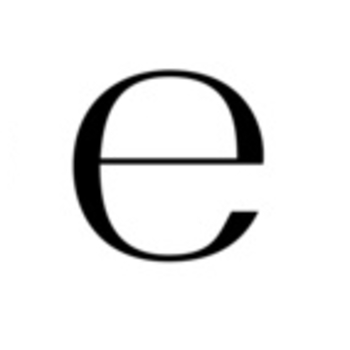
The "e" symbol on packaging states the actual content of pre-packed products. This is also called the nominal weight or nominal volume. Since this quantity often cannot be filled to the gram or millilitre in production, the EU directive 76/211/EEC (also called the "pre-packing directive") specified a maximum permitted deviation and introduced the estimate mark "e".
For example, the content of a sugar pack with 1,000 g may deviate up or down by up to 15 grams, as indicated by the weighing sign, the small "e" on the packaging. It must be printed at least 3 mm high.
For example, the content of a sugar pack with 1,000 g may deviate up or down by up to 15 grams, as indicated by the weighing sign, the small "e" on the packaging. It must be printed at least 3 mm high.
Recycling symbols: meaning and material marking

In order to increase the recycling ratio in sorted materials (in particular packaging materials), the Packaging Act requires marking with a recycling code. The recycling marks on packaging materials symbolise the recycling cycle. They contain a number from 1 to (currently) 98 for the material. It not only indicates the abbreviation for the plastic type (e.g. PVC for polyvinylchloride), but includes recycling codes for fabrics, paper types, metals and glass.
Tidyman
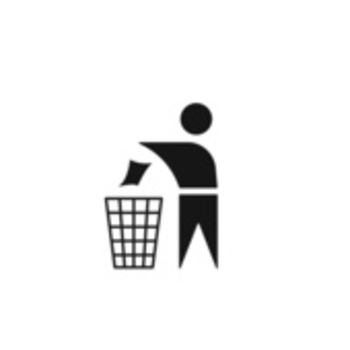
The "tidyman" is to remind consumers to dispose of the used packaging, cans, etc. in an environmentally compatible way after use. The icon, which first appeared in the 1960s and was probably first used in the USA, is a voluntary mark used in the industry. By now, it can be found on millions of products internationally and is understood around the world.

REINER® product solutions
The right device for almost every requirement.
We offer different inject printers depending on your needs and area of application.
Select the right marking device for you from our product variety:
To the handheld inkjet printer
Printing identity marks
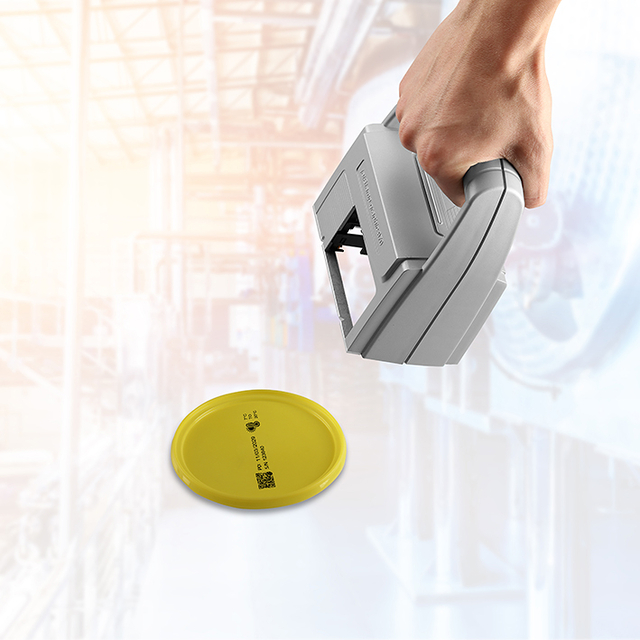
The EU regulation (EC) no. 853/2004 requires identity marks, officially called the "identification and health marks", from the producers of dairy products, meat, fish and egg products. These marks state the country and a five-digit code for the company that last treated or packed the product.
Cosmetics / Medicinal Products: Frequent Symbols and Icons
Printing on the best-before date
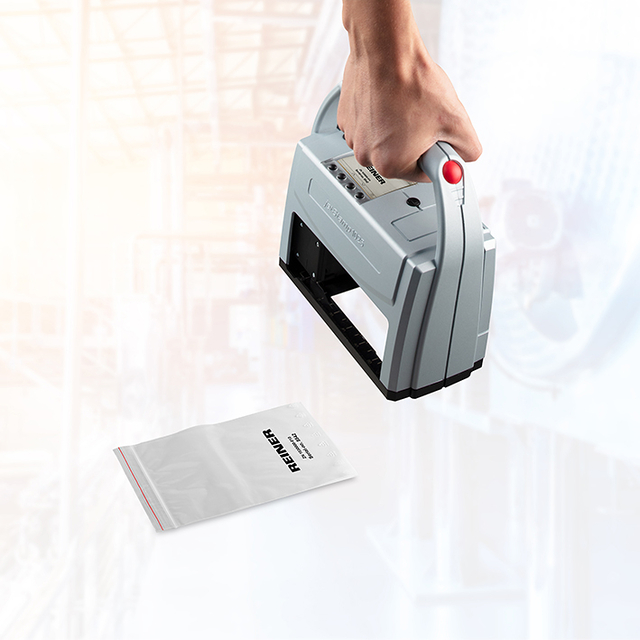
Unopened cosmetics in their original packaging that will keep for less than 30 months are marked with the legally required hourglass symbol and a best-before date. The date until which the manufacturer warrants impeccable quality of its product is printed next to it or below it. The European regulation (EG) no. 1223/2009 concerning cosmetic products stipulates details on the use and application in the respective product areas.
Printing the use-by time
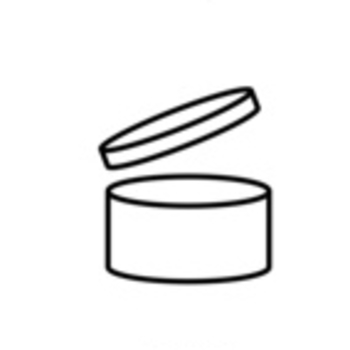
In addition to the best-before date, EC directive 2003/15/EC introduced a symbol to mark cosmetics that remain usable for more than 30 months, to state how long cosmetics can be used after opening without any fear of adverse effects or harm. Though the symbol, which symbolises a cream pot, is drawn with comparably thin lines, it can be printed out perfectly thanks to the high print resolution with REINER® marking devices.
Printing the lot number
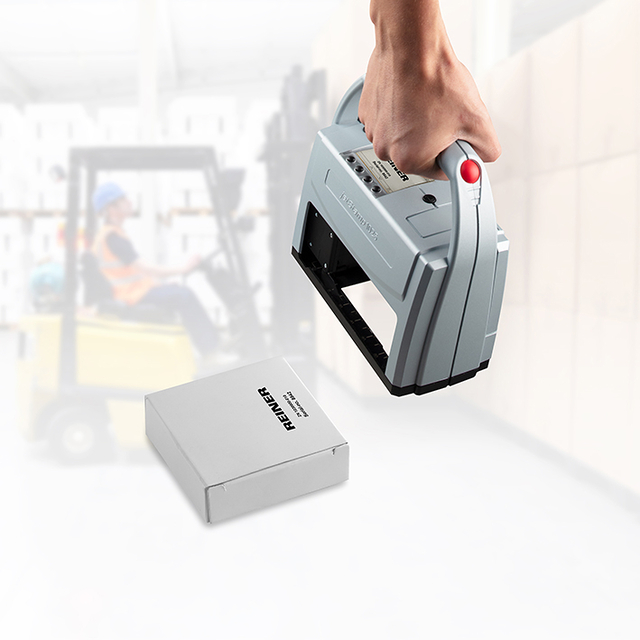
A lot is the total amount of a specific product that is generated, produced or packed under the same conditions. The producer uses the lot number to mark a delivery or production quantity,
• e.g. based on the same raw material delivery,
• produced by the same employees within one work shift,
• produced on the same machines, or
• sharing another relevant production feature.
For medicines, this designation is firmly specified as "Ch.-B." (for "Chargen-Bezeichnung"; lot designation) by §10 of the Medicines Law in Germany.
Every LOT number or "Ch.-B." must be clearly legible and identifiable. It can be printed onto the product packaging or directly onto the product.
• e.g. based on the same raw material delivery,
• produced by the same employees within one work shift,
• produced on the same machines, or
• sharing another relevant production feature.
For medicines, this designation is firmly specified as "Ch.-B." (for "Chargen-Bezeichnung"; lot designation) by §10 of the Medicines Law in Germany.
Every LOT number or "Ch.-B." must be clearly legible and identifiable. It can be printed onto the product packaging or directly onto the product.
Drawing attention to the usage instructions
This symbol is required to mark medicinal products. It reminds the user to observe the enclosed instructions before use or application. The symbol and its application are described by DIN EN ISO 15223-1:2017.
Electrical Devices and Electronics: Manufacturer's Logo and Information on Products
WEEE marking for special waste – the crossed-out garbage bin
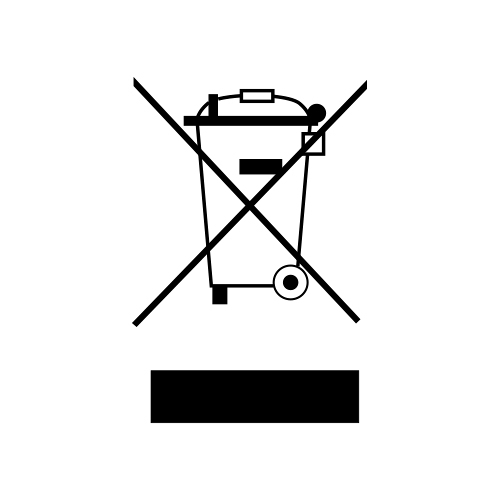
The crossed-our garbage bin on electrical and electronic devices is to keep consumers from throwing the devices into domestic waste. The requirement is stipulated in the WEEE directive 2012/19/EU, in which WEEE is short for "Waste of Electrical and Electronic Equipment". This is colloquially referred to as "electronic scrap". After all, such devices not only contain raw materials that are valuable for reuse, but may lead to special environmental and health risks if they end up in landfills for domestic waste. The WEEE symbol size requirements can easily be retained with the flexible REINER® printers.

REINER® MarkingPartner in your area
Are you looking for an authorized dealer near you? Simply enter your country and postal code and the nearest marking partners will be displayed, like AUTOMATED MARKING INC. in the USA.
To REINER® MarkingPartner
The CE seal
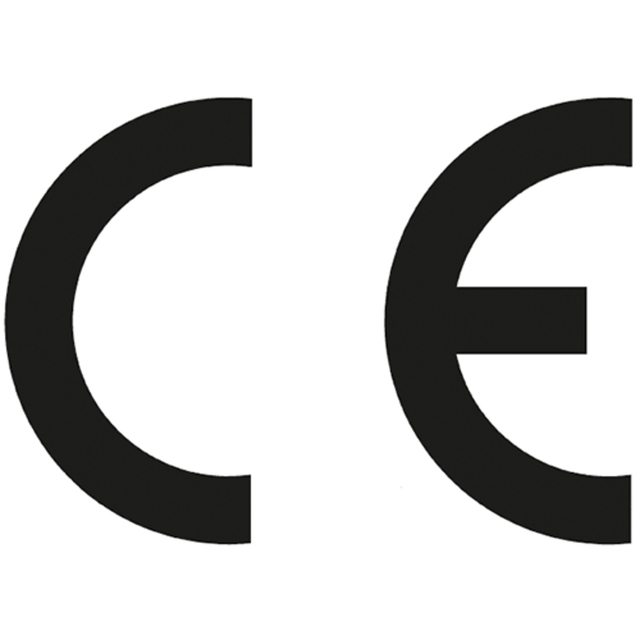
The CE label is likely one of the most frequently seen product markings. A CE sticker or CE imprint is applied by manufacturers or importers in the European Union to declare that "the product meets the applicable requirements as specified in the harmonisation legislation of the community regarding their application". After compiling an EU declaration of conformity, the manufacturer can print the CE mark onto the product and its packaging. This symbol is relevant for nearly all products sold in the European Union.
The GS
As a test mark stipulated by law, the GS mark represents product safety and certifies that the product marked with it meets the requirements of § 21 of the Product Safety Act (Produktsicherheitsgesetz; ProdSG). Requirements to "size and number" in various DIN-standards, EU-standards and other "accepted rules of the art" must be met for a product to be deemed GS-compliant.
Wooden Pallets: Marking for Packaging Materials
Printing IPPC / ISPM 15
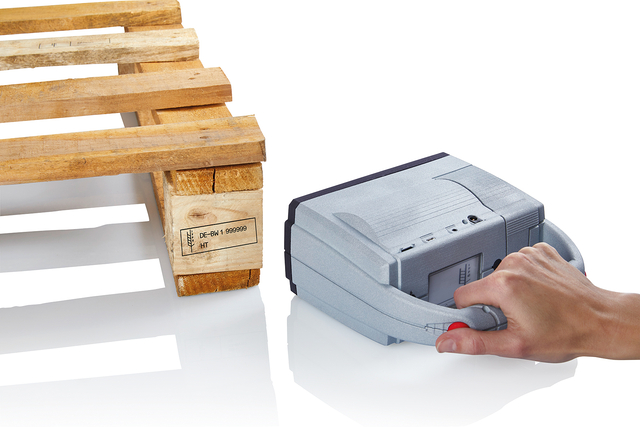
The UN sub-organisation "International Plant Protection Convention" (IPPC) has the task of preventing and controlling the spread and introduction of diseases with plants and plant products. The IPPC standard "ISPM 15" (International Standard of Phytosanitary Measures) developed by them created the basis for global harmonisation of the protective measures and import provisions. The IPPC stamp means that the manufacturer declares that these standards are complied with. It is mostly printed on wooden pallets and wooden boxes. IDs for the country, region and register number in the IPPC stamp, as well as the wood treatment method, make product origins trackable.
The mobile inkjet printer jetStamp® 1025 puts an end to the special challenge of individually marking wood products!
The dedicated software allows the user to position the country and regional ID, register number and treatment method abbreviations in the right location simply by clicking the mouse. Meeting IPPC requirements becomes a breeze.
The times, dates and sequentially numbered barcodes can be printed on as well in four customisable imprint layouts.
The mobile inkjet printer jetStamp® 1025 puts an end to the special challenge of individually marking wood products!
The dedicated software allows the user to position the country and regional ID, register number and treatment method abbreviations in the right location simply by clicking the mouse. Meeting IPPC requirements becomes a breeze.
The times, dates and sequentially numbered barcodes can be printed on as well in four customisable imprint layouts.
Universal graphics printing is only the beginning: the REINER jetStamp®
product family
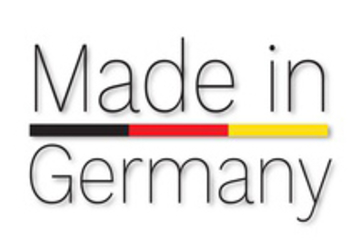
The REINER® marking devices can master any graphical printing task with flying colours, no matter if it serves creative freedom or legal obligations. The push of a button is all it takes!
The fast-drying REINER® ink P3-MP3 ensures optimal adhesion on many different material surfaces. Delamination due to moisture, oil contamination or abrasion, which is a common issue of paper or foil labels, are now things of the past.
Sparing consumption of ink and the long battery life make the REINER® marking devices valued colleagues at work. The mobile inkjet printer jetStamp® 1025 patiently waits through longer breaks without drying out, thanks to the special protection mechanism placed above the printing head. The REINER® handheld inkjets are consistently aligned with mobile use and characterised by their robustness and reliability without any reductions in precision and technical refinement.
The fast-drying REINER® ink P3-MP3 ensures optimal adhesion on many different material surfaces. Delamination due to moisture, oil contamination or abrasion, which is a common issue of paper or foil labels, are now things of the past.
Sparing consumption of ink and the long battery life make the REINER® marking devices valued colleagues at work. The mobile inkjet printer jetStamp® 1025 patiently waits through longer breaks without drying out, thanks to the special protection mechanism placed above the printing head. The REINER® handheld inkjets are consistently aligned with mobile use and characterised by their robustness and reliability without any reductions in precision and technical refinement.






